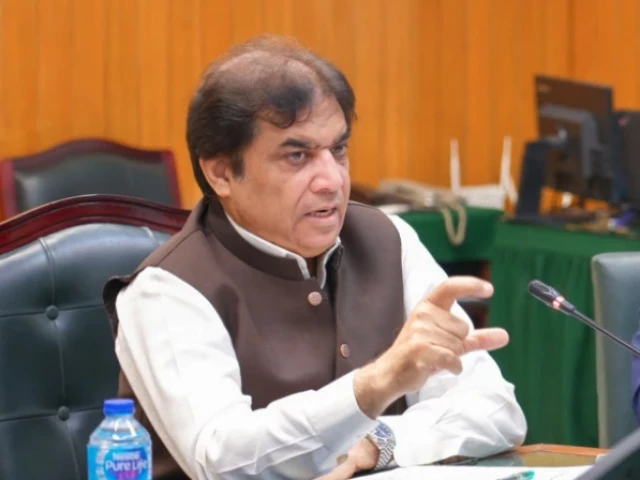Business
PR launches property recovery worth Rs65b | The Express Tribune

KARACHI:
Federal Minister for Railways Muhammad Hanif Abbasi on Thursday unveiled reforms, recovery measures, and development projects aimed at modernising Pakistan Railways and making it more efficient, transparent, and business-friendly.
During a visit to the Karachi Chamber of Commerce and Industry (KCCI), Abbasi said that railway lands worth Rs15 billion had been recovered, while properties worth another Rs50 billion would be retrieved this year. He clarified that railway property is non-saleable, though revenue-sharing partnerships are being pursued for better use.
Highlighting Karachi’s role, Abbasi remarked, “Without Karachi, Pakistan’s economy collapses, and without Karachi Division, Railways ceases to exist.” He said the Thar coal transport project was progressing nationwide, while groundbreaking for the 480km KarachiRohri line is expected by June 2026.
On modernisation, the minister said 155 stations are being shifted to solar power, including 27 in Karachi. So far, 60 stations have been solarised. Wi-Fi is being installed at 40 stations, and ATM and Wi-Fi services will be expanded to all major stations. A new CIP lounge at Karachi Station will open on September 22, while railway saloons have been made available to the public at affordable rates.
Abbasi said Pakistan Railways had initiated digitisation and reduced losses. Regularisation of meters saved Rs4 billion, while ticket theft earlier cost Rs1 billion annually. He warned that ticketless travellers and facilitators would face imprisonment, stressing that “even ministers or Railways chairman will have to buy tickets.”
The minister announced that 11 passenger trains had already been outsourced, with nine more to follow within six days. By December, 38 trains will be outsourced. Freight trains are also being outsourced to meet rising demand. Two trains have been handed to NLC, which is seeking 10 more. Eight railway hospitals and 14 schools are also being outsourced, though employees will continue to receive free medical care.
Abbasi admitted that trains were facing delays due to floods, while fares could not be reduced immediately. He said bogies and engines received eight years ago were of such poor quality that they had worn out despite a 30-year life expectancy. An inquiry has been ordered.
Business
47.7% of Mutual Fund Assets Now Invested Directly, ICRA Analytics Says

Last Updated:
ICRA Analytics reports 65.30 percent retail investors used Non-Associate Distributors, while 27.37 percent invested directly.

Retail Investors Prefer Distributor Route; Direct Investments at 27.37%: ICRA Analytics
Approximately 27.37% of retail investors opted for direct investments, while 65.30% of retail investors came through the route of Non-Associate Distributors as of September 30, according to ICRA Analytics. Additionally, 47.70% of the mutual fund industry’s assets were invested directly and 45.96% came from Non-Associate Distributors, ICRA Analytics added.
Direct investment refers to investment directly with the mutual fund company (AMC), where there is no commissions or intermediary fees, making the expense ratio (cost of managing the fund) lower.
Data from AMFI showed that 19% of the assets of the mutual fund industry came from B30 locations in Sep 2025. Assets from B30 locations increased from Rs 14.14 trillion in Aug 25 to Rs 14.50 trillion in Sep 25, representing growth of 2.6%. B30 means Beyond Top 30 cities, including all other smaller towns and cities outside those top 30 (T30) cities.
Assets from T30 locations also grew 14% on a yearly basis in Sep 2025.
B30 location continued to tend towards equity assets. “Nearly 76.60% of the assets from B30 locations are in equity schemes and 9.12% in balanced schemes in Sep 2025,” ICRA Analytics added.
Close to 11.67% of the assets from B30 location are in debt-oriented schemes, while the same from T30 location accounts for 30.39%.
Nearly 28.90% of High Net Worth Individual (HNI) assets were directly invested.
ICRA Analytics earlier said that domestic equity markets rose following robust macroeconomic indicators, as India’s economy expanded by 7.8% YoY in Q1 FY26, marking the strongest growth in five quarters, while the Services PMI surged to 62.9 in Aug 2025. its highest level in over 15 years, driven by a sharp rise in new orders and resilient demand.
Sentiment was further boosted as the GST Council simplified the existing four tax slabs (5%, 12%, 18%, 28%) into a two-rate structure of 5% & 18% and proposed a special 40% slab for select luxury items such as high-end cars, tobacco, and cigarettes. Gains extended after the U.S. Federal Reserve delivered its first rate cut of the year in Sep 2025, citing recent weakness in the labor market. However, overall gains were capped amid lingering uncertainty over India–U.S. trade negotiations and continued foreign institutional investor outflows from domestic equities.

Varun Yadav is a Sub Editor at News18 Business Digital. He writes articles on markets, personal finance, technology, and more. He completed his post-graduation diploma in English Journalism from the Indian Inst…Read More
Varun Yadav is a Sub Editor at News18 Business Digital. He writes articles on markets, personal finance, technology, and more. He completed his post-graduation diploma in English Journalism from the Indian Inst… Read More
October 24, 2025, 18:16 IST
Read More
Business
Lesson from China’s export restrictions: India eyes fertilizer plant project in Russia; aim to protect against supply shocks – The Times of India

Indian fertiliser companies are preparing to set up a urea manufacturing facility in Russia, a move that is likely to be announced during Russian President Vladimir Putin’s visit to India in December. This would be India’s first fertiliser venture in Russia.The plant will use Russia’s abundant ammonia and natural gas reserves, ensuring a stable supply of this key agricultural input and reducing India’s reliance on volatile global prices, according to a report by ET.State-owned Rashtriya Chemicals and Fertilisers (RCF) and National Fertilisers Ltd (NFL), along with government-backed Indian Potash Ltd (IPL), have signed a non-disclosure agreement (NDA) with Russian partners to begin planning the project, the report said.The plant is expected to produce over 2 million tonnes of urea annually. Negotiations are ongoing on land allocation, natural gas, ammonia pricing and transportation logistics.India depends largely on imports of raw materials like ammonia and natural gas for its domestic fertilizer production.The Russian facility is expected to shield India from future price shocks and supply disruptions. It will also strengthen economic ties between the two countries, which already collaborate in energy, defence and agribusiness.The project comes after India faced an acute fertiliser shortage during this year’s kharif (monsoon) season, when China temporarily halted exports of urea and other nutrients.The disruption forced India to seek supplies from other markets at higher costs, raising concerns about food production.Demand for fertilizers has gone up due to well-distributed monsoon rains. Consequently, nutrient-rich crops like maize are being grown by farmers.During the winter season, the need for urea increases even further for rabi crops such as wheat.In order to keep fertilisers accessible and affordable for farmers, they are regulated and subsidised in India, contributing to food security. The burden of government subsidies rises as global prices rise.The initial budget of Rs 1.68 lakh crore was increased to Rs 1.92 lakh crore for FY25 for the Department of Fertilisers. India’s domestic urea production hit a record 31.4 million tonnes in FY24.Despite these efforts, India still relies heavily on imports for raw materials and is the second-largest user as well as the third-largest producer of fertilizers globally.
Business
Strike dates set in union’s pay dispute with defence company Leonardo

Workers at a leading defence and aerospace company are set to go on strike in November in a dispute over pay.
Unite says more than 3000 workers at Leonardo UK’s facilities in Scotland and England will walk out after the company refused to improve its pay offer.
The company is involved in a number of defence projects, with its site in Edinburgh producing advanced radars for military aircraft.
Workers at Leonardo’s Edinburgh and Newcastle sites will strike between November 5 and 6, then again between November 10 and 18.
At the Yeovil, Luton and Basildon sites, workers will strike between November 5 and 6, then again between November 12 and 13.
Union officials said staff were refused a better deal after declining the initial offer of 3.2%, which the union said represents a real-terms pay cut.
Unite general secretary Sharon Graham said: “Our members are highly skilled and work on critical defence and aerospace systems, yet are being short-changed by a company making billions.
“Leonardo has had ample opportunity to do the right thing and make a decent offer that our members could have accepted. Instead, they have refused and will now see the anger of our members on the picket line outside their factories.
“This is a dispute entirely of their own making and our members will have the full support of Unite in their fight for decent pay.”
Leonardo UK has been approached for comment.
-

 Tech1 week ago
Tech1 week agoWhy the F5 Hack Created an ‘Imminent Threat’ for Thousands of Networks
-

 Tech5 days ago
Tech5 days agoHow to Protect Yourself Against Getting Locked Out of Your Cloud Accounts
-

 Business1 week ago
Business1 week agoBaroness Mone-linked PPE firm misses deadline to pay £122m
-

 Tech6 days ago
Tech6 days agoI Tested Over 40 Heat Protectant Sprays to Find the Best of the Best
-

 Sports6 days ago
Sports6 days agoPCB confirms Tri-nation T20 series to go ahead despite Afghanistan’s withdrawal – SUCH TV
-

 Sports1 week ago
Sports1 week agoU.S. Soccer recommends extending NCAA season
-

 Business5 days ago
Business5 days agoDiwali 2025: Gold & silver likely to consolidate next week; Here’s what analysts said – The Times of India
-

 Tech1 week ago
Tech1 week agoSAP ECC customers bet on composable ERP to avoid upgrading | Computer Weekly











